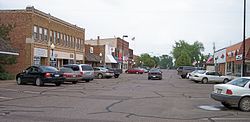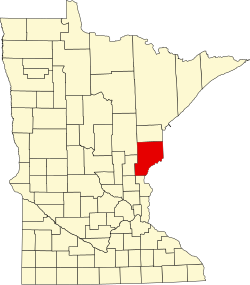Hinckley Gaa-zhiigwanaabikokaag | |
|---|---|
 Main Street in downtown Hinckley in 2007 | |
 Location of the city of Hinckley within Pine County, Minnesota | |
| Coordinates: 46°0′44″N92°56′32″W / 46.01222°N 92.94222°W | |
| Country | United States |
| State | Minnesota |
| County | Pine |
| Incorporated (village) | 1885 [1] |
| Incorporated (city) | November 27, 1907 [1] |
| Government | |
| • Mayor | Donald Zeman [2] |
| Area | |
• Total | 3.83 sq mi (9.93 km2) |
| • Land | 3.79 sq mi (9.81 km2) |
| • Water | 0.050 sq mi (0.13 km2) |
| Elevation | 1,014 ft (309 m) |
| Population (2020) | |
• Total | 1,904 |
| • Density | 502.9/sq mi (194.18/km2) |
| • Demonym | Hincklian |
| Time zone | UTC-6 (Central (CST)) |
| • Summer (DST) | UTC-5 (CDT) |
| ZIP code | 55037 |
| Area code | 320 |
| FIPS code | 27-29294 [5] |
| GNIS feature ID | 2394390 [4] |
| Website | www.hinckley.govoffice2.com |
Hinckley is a city in Pine County, Minnesota, United States, located at the junction of Interstate 35 and Minnesota State Highway 48. The population was 1,904 at the 2020 census.
Contents
- Geography
- Climate
- History
- Demographics
- 2010 census
- 2000 census
- Education
- Notable people
- References
- External links
Hinckley's name in the Ojibwe language is Gaa-zhiigwanaabikokaag, [6] [7] meaning "the place abundant with grindstones" due to being located along the Grindstone River. Portions of the Mille Lacs Indian Reservation are located within and adjacent to Hinckley.
On September 1, 1894, the Great Hinckley Fire killed more than 400 people.
Hinckley is generally considered the halfway point on Interstate 35 between Minneapolis–Saint Paul and Duluth.


